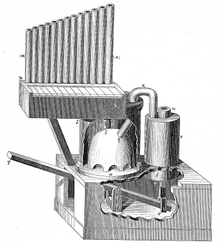Ktesibios
Ktesibios from Alexandria ( Greek Κτησίβιος ὁ Ἀλεξανδρεύς) was a Greek technician, inventor and mathematician who lived in the first half of the 3rd century BC. . AD lived.
Ktesibios worked under Ptolemy I and Ptolemy II in the library of Alexandria . He is considered one of the very first technicians. His pupil was probably Philo of Byzantium . His designs were known to Heron of Alexandria and Vitruvius . In his father's barber shop, Ktesibios is said to have installed a height-adjustable mirror and discovered the physicality and ability of the air to work. His work "Περὶ τῶν πνευματικῶν" ( pneumatics ) was groundbreaking.
The most important inventions are:
- Spring catapult (air tensioner): air was compressed in (two) bronze cylinders and thus bronze leaf springs were pretensioned. When the valves were opened, items such as B. Thrown stones.
- Fire engine (suction and pressure pump): The most important invention of the Ktesibio was the combined suction and pressure pump, which was later used with an attached hose for fire extinguishing.
- Water clock with gear drive: The time was measured by running water into a closed vessel using a pointer (vertical hour scale) attached to a cork float. Figures were also rotated by cogwheels on racks. Another version moved the hour display calculated for each time of day via cogwheels on a rotating cylinder. A replica is now in the Deutsches Museum in Munich.
- Water organ: With the water organ of the Ktesibios ( organon hydraulikon ) , like the pressure pump, air was compressed to generate sounds. This invention found widespread use , particularly in ancient Rome .
- Water level regulator : A kind of self-closing valve and thus an anticipation of the principle of control technology
In 1976 the moon crater Ctesibius was named after him.
literature
- Jean-Marie Flamand: Ctésibios d'Alexandrie. In: Richard Goulet (ed.): Dictionnaire des philosophes antiques , Volume 2. CNRS Éditions, Paris 1994, ISBN 2-271-05195-9 , pp. 529-530
- Fritz Krafft : Ktesibios. In: The New Pauly (DNP). Volume 6, Metzler, Stuttgart 1999, ISBN 3-476-01476-2 , Sp. 876-878.
- Kurt Orinsky : Ktesibios 2. In: Paulys Realencyclopädie der classischen Antiquity Science (RE). Volume XI, 2, Stuttgart 1922, Sp. 2074-2076.
Web links
- Heike Le Ker: Automata of antiquity: How the gods opened the temple doors. In: Spiegel Online . April 9, 2009 .
Individual evidence
| personal data | |
|---|---|
| SURNAME | Ktesibios |
| ALTERNATIVE NAMES | Ktesibios from Alexandria; Ktesibos the Alexandrians |
| BRIEF DESCRIPTION | Greek inventor |
| DATE OF BIRTH | 296 BC Chr. |
| PLACE OF BIRTH | Alexandria |
| DATE OF DEATH | 228 BC Chr. |
